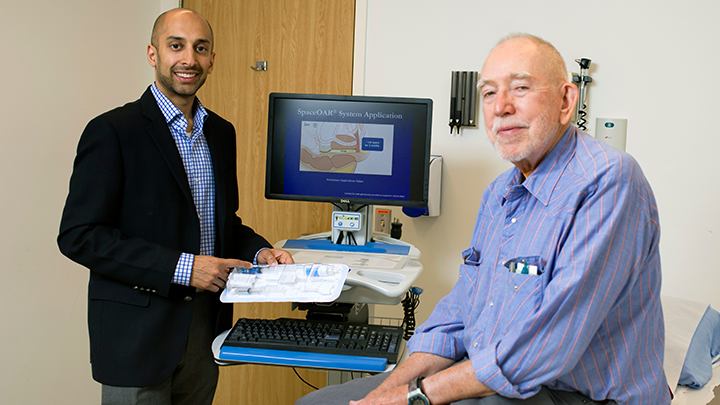
October 2, 2018

Dr. Nawaid Usmani, left, poses with patient Jan Murie, who underwent radiation treatments for prostate cancer after an injection of SpaceOAR gel.
Story by Greg Harris | Photo by Brian Brady
EDMONTON — A new product that reduces the risk of healthy tissue being damaged during radiation therapy is benefiting a small, but growing number of men in Edmonton with prostate cancer.
Dr. Nawaid Usmani, a radiation oncologist at the Cross Cancer Institute, has introduced the use of a synthetic gel called SpaceOAR that creates additional space between the prostate and rectum. He is currently the only physician in the province using it.
Since late 2017, some 14 patients have received radiation therapy after having the gel injected. Composed mostly of water, the gel is naturally absorbed by the body sometime after a typical two-month course of radiation treatment.
“It has worked exceptionally well,” says Dr. Usmani. “It is easy to do and safe. Right now we’re using it in patients whose anatomy shows their prostate being situated close to the rectum.”
If the rectum becomes damaged by radiation, it can lead to complications such as bleeding, pain or the formation of a fistula, which is the creation of a secondary passageway from the rectum.
Jan Murie, a 79-year old Edmonton man who was diagnosed with prostate cancer in late 2017, completed about 40 radiation therapy sessions after undergoing the procedure.
“It worked beautifully for me. I was a little wary after my experience with the biopsy, but aside from a little discomfort, I hardly felt a thing,” Murie says of the 30-minute procedure used to inject the gel.
Guided by ultrasound, Dr. Usmani locates the one- to five-millimetre space between the prostate and rectum, then injects two liquids that mix and solidify. The resulting mass maintains its volume from between three to six months.
The company that manufactures SpaceOAR provides training in the procedure to administer it.
Dr. Usmani says most people tolerate radiation therapy quite well, but the gel provides another margin of safety in patients whose anatomy puts them at greater risk of damage to healthy tissue.
“We’ve confirmed that our own results look as good as the published data,” Dr. Usmani says. “Our intention is to continue to offer this to appropriate patients, and assess whether there would be benefits to offering it more widely.”
Murie recently learned that his prostate-specific antigen (PSA) count was near zero and that there is no enlargement of his prostate, both positive indicators in assessing for a recurrence of cancer.
“The possible negative side effects from the radiation therapy were minimal,” says Murie, “and perhaps the gel treatment was at least partially responsible for that.”